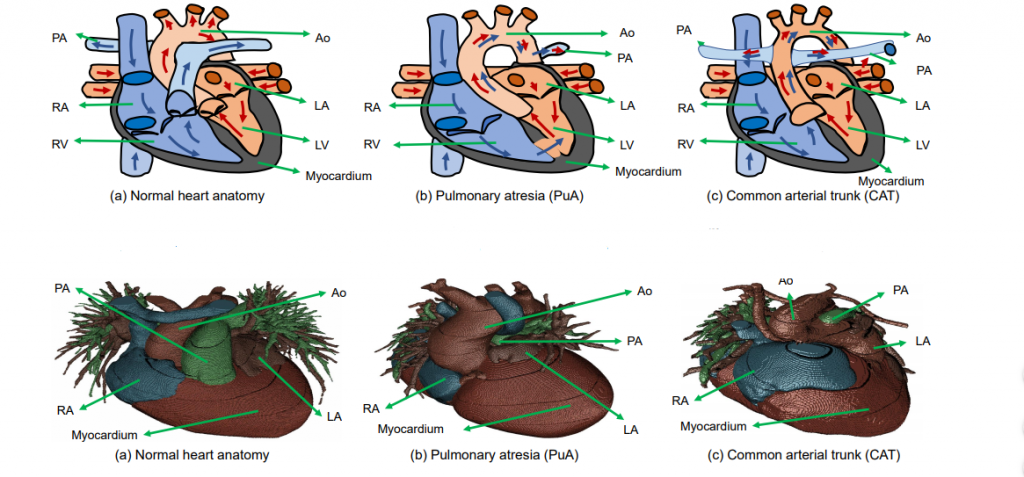Scientists Use 3D Printed Models to Further Congenital Heart Disease Studies
In the recently published ‘Accurate Congenital Heart Disease Model Generation for 3D Printing,’ researchers explore 3D printing for diagnosis, treatment, and planning in congenital heart disease (CHD) patients. CHD usually presents itself at birth and can be difficult to analyze, even with 3D medical images—and despite many different studies by scientists around the world. The researchers note that 3D printing has been ‘widely adopted’ in clinical settings lately, offering for improvements in the following:
- Clinical decision making
- Interventional planning
- Communication between physicians and patients
- Improving medical education

(Top) Examples of large structure variations in CHD. In normal heart anatomy (a), PA is connected to RV. However, in pulmonary atresia (b), PA is rather small and connected to descending Ao. In common arterial trunk (c), Ao is connected to both RV and LV, and PA is connected to Ao. (Bottom) Pulmonary atresia and common arterial trunk examples in our dataset, with large variations from normal heart anatomy.
In the dataset for this research, combining deep learning and graph matching for whole heart and great vessel segmentation in CHD, patients ranged in age from one month to 21 years old—while most were from one month to two years old. Out of 16 cases, the study covers 14 types of CHD to include the most common 8, which are atrial septal defect (ASD), atrio-ventricular septal defect (AVSD), patent ductus arteriosus (PDA), pulmonary stenosis (PS), ventricular septal defect (VSD), co-arctation (CA), Tetrology of Fallot (ToF), and transposition of great arteries (TGA).

Overview of the proposed framework combining deep learning and graph matching for whole heart and great vessel segmentation in CHD.
The researchers explain that there has already been a prolific amount of research using the multi-modality whole heart segmentation method, with ‘state-of-the-art performance’ found in combining 3D U-net for segmentation and a simple convolutional neural network for label position prediction. Another technique involves using the basic simple convolutional neural network for label position prediction, while another handles blood pool and myocardium in blood pool segmentation.
“Considering the significant variations in heart structures and great vessel connections in CHD, almost all the existing methods cannot effectively perform whole heart and great vessels segmentation in CHD,” state the researchers.
Motivated instead by the promise of graph matching, they used deep learning and graph matching, collecting 68 CT images overall, with an 11.9 percent higher Dice score. The framework consisted of:
- Region of interest cropping
- Chambers and myocardium segmentation
- Blood pool segmentation
- Chambers and myocardium refinement
- Graph matching
Segmentation results were printed on a Sailner J501Pro for evaluation—a process that took the researchers about three to four hours. The researchers assessed the 3D printed model as correct, and with clear shape and connections, with minor refinements necessary such as thin coronary vessels.
“We also printed out part of the segmentation results with minor manual refinement and showed that it can be applied to clinic use,” concluded the researchers.
3D printed models have proven to be more than just helpful in many different areas of the medical realm, especially as they are able to offer so much in terms of education not only for students but also for patients and their families, as well as helping in the preoperative stages—and during the actual operation too with surgical planning models.

(Top) Visualized comparison between the state-of-the-art method Seg-CNN [12] and our method. The differences from the ground truth are highlighted by the red circles. (Bottom) Examples of 3D printing models using our method with some minor manual refinement.
Subscribe to Our Email Newsletter
Stay up-to-date on all the latest news from the 3D printing industry and receive information and offers from third party vendors.
Print Services
You May Also Like
3D Printing News Briefs & Events Roundup: March 15, 2025
In this weekend’s combined 3D Printing News Briefs and Webinars/Events Roundup, we’re covering news about automotive and construction 3D printing, along with AM Forum, TCT Asia, the Experience Stratasys Tour,...
3D Printing News Briefs & Events Roundup: March 8, 2025
Starting this week, we’re shaking things up a little! We’ll be combining our 3D Printing News Briefs with a more curated weekly list of 3D printing webinars and events to...
Combinatory Manufacturing, Happening at Last?
In 2009, I introduced the concept of “combinatory manufacturing” while at Shapeways. This approach integrates 3D-printed components with conventionally manufactured ones to create end-use products. Unlike merely using 3D printing...
Boston’s Additive Edge: Fluent Metal’s Approach to Liquid Metal 3D Printing
Stepping into the heart of Boston’s innovation landscape, I found myself at Fluent Metal’s headquarters in Cambridge. From the moment I walked through the doors of the startup’s space, the...

























